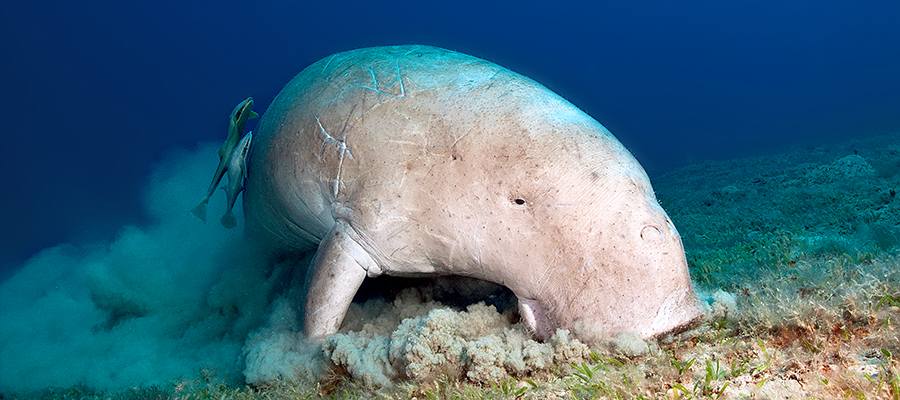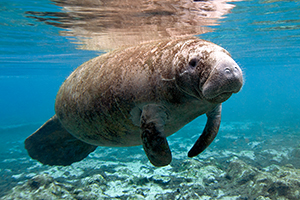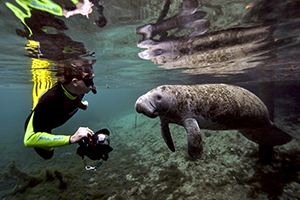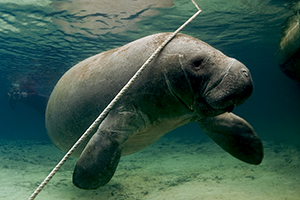Sea cows: There are 4 different species of sea cows ...
 Sea cows usually stay in shallow waters and graze on the bottom.
Sea cows usually stay in shallow waters and graze on the bottom.
Did you know? ...
+ Anemonefish+ Frogfish
+ Lionfish
+ Mandarinfish
+ Moray eels
+ Rhinopias
+ Ghost pipefish
+ Sea cows
+ Seahorses
The dugong is very often confused with the lamantin, also known as the manatee. But an encounter with one of these special marine mammals remains impressive. This small group of mammals, which are described as the sea cows, includes only four species: the Amazonian manatee, the Caribbean manatee, the West African manatee and the dugong.
Sea cows are sturdy animals and move forward by floating or swimming. The nostrils are located on top of the snout, which is covered with hard whiskers. Their front legs are like changed into flippers and the tail is transformed into one big flat fin. Sea cows are on average about forty years old. Their age can be up to sixty years and the dugong can even reach the age of 75 years. Sea cows are on average between three and four meters long and can their weight is between 350 to 600 kg.
The big difference between the dugong and the manatee is mostly in the shape of the tail. The tail of the manatee is rather spoon-shaped or round while the tail of the dugong looks like a Dolphin's tail and is therefore more V-shaped. And while the dugong is rather beige to gray brown, manatees are more plain gray to dark gray. Sometimes however, the manatee is so overgrown with algae that they look rather green.
Sea cows usually stay during the summer months at sea. In the winter months, however, they are looking for slightly warmer waters and they can be much easier found in places where they're staying during winter time. Manatees even seek brackish or freshwater to overwinter.
 A dugong in Marsa Alam (Egypt)
A dugong in Marsa Alam (Egypt)
 A manatee in Cristal River (Florida)
A manatee in Cristal River (Florida)
 Bruno together with a lamantin
Bruno together with a lamantin
The best location in the world to see manatees - and to photograph them - might be Crystal River, a place
located in the US, Florida. This river is connected to the Gulf of Mexico and consists of a network of canals
with a few hot freshwater springs. In the winter manatees are regularly seen here, and this sometimes in very large quantities.
But the water there is not always as clear as the name suggests and the temperature is only slightly just above 20 degrees Celsius.
The dugong is found especially in tropical waters. The largest population lives in Australia. But also in Egypt divers have regular encounters with these rather large mammal species. Near Marsa Alam you can find some massive seagrass beds. And manatees are true herbivores.
Sea cows usually stay in shallow waters and graze on the bottom. They feed primarily on sea grass, algae and other aquatic plants. While grazing, they sometimes pull the entire plant and leave only large bare patches of sand behind. They come every three to five minutes to the surface to breathe. When they are not up to the grazing, they are resting and sometimes they lie motionless on the ground. During these breaks, a dive can take up to twenty minutes before they appear on the surface, to then disappear again to the bottom and continue their rest.
The manatee is sexually mature at five to nine years old. Mating is not seasonal and the female is usually every three to five years pregnant. The calf is born after a gestation period of twelve to fourteen months. Afterwards calf and mother reamin closely together and they make almost constant body contact. The suction takes place on the nipple which is located just behind the front fin. Partly because of the position of the nipples, and the three to four nails of the pelvic fin manatees are most closely related to the family of the elephants. At the age of two, the calf leaves the mother and goes his own way.
In sea manatees have few enemies. Outside the sharks and killer whales the biggest enemy is actually people. The manatees in Florida love to be scratched and therefore even search contact with humans. They're not shy and harmless. But this means that they often collide with the pleasure boats of surely one of the top attractions of Florida: snorkeling with the manatee. Many animals have deep scars caused by ship propellers. This is also the leading cause of death of one of our gentle giants of the oceans: the nearly extinct manatee.
Species of sea cows :
The dugong is found especially in tropical waters. The largest population lives in Australia. But also in Egypt divers have regular encounters with these rather large mammal species. Near Marsa Alam you can find some massive seagrass beds. And manatees are true herbivores.
Sea cows usually stay in shallow waters and graze on the bottom. They feed primarily on sea grass, algae and other aquatic plants. While grazing, they sometimes pull the entire plant and leave only large bare patches of sand behind. They come every three to five minutes to the surface to breathe. When they are not up to the grazing, they are resting and sometimes they lie motionless on the ground. During these breaks, a dive can take up to twenty minutes before they appear on the surface, to then disappear again to the bottom and continue their rest.
The manatee is sexually mature at five to nine years old. Mating is not seasonal and the female is usually every three to five years pregnant. The calf is born after a gestation period of twelve to fourteen months. Afterwards calf and mother reamin closely together and they make almost constant body contact. The suction takes place on the nipple which is located just behind the front fin. Partly because of the position of the nipples, and the three to four nails of the pelvic fin manatees are most closely related to the family of the elephants. At the age of two, the calf leaves the mother and goes his own way.
In sea manatees have few enemies. Outside the sharks and killer whales the biggest enemy is actually people. The manatees in Florida love to be scratched and therefore even search contact with humans. They're not shy and harmless. But this means that they often collide with the pleasure boats of surely one of the top attractions of Florida: snorkeling with the manatee. Many animals have deep scars caused by ship propellers. This is also the leading cause of death of one of our gentle giants of the oceans: the nearly extinct manatee.
Species of sea cows :
 Dugong dugon
Dugong dugon
 Trichechus manatus
Trichechus manatus